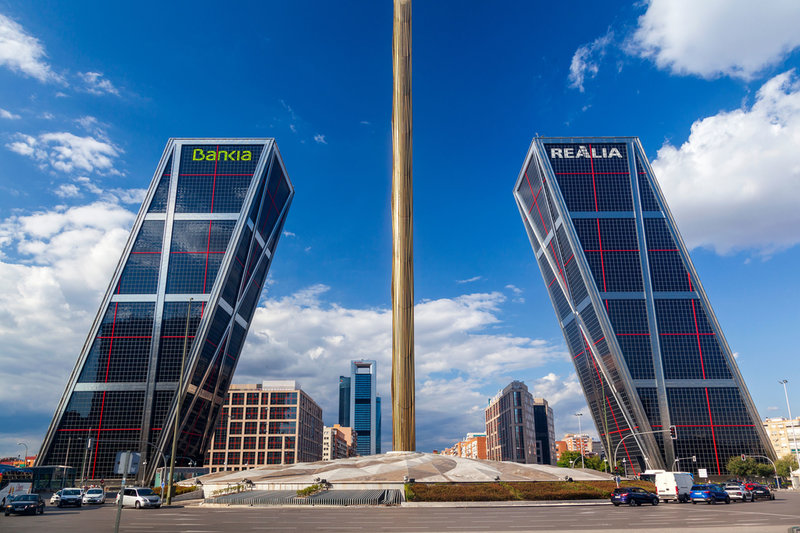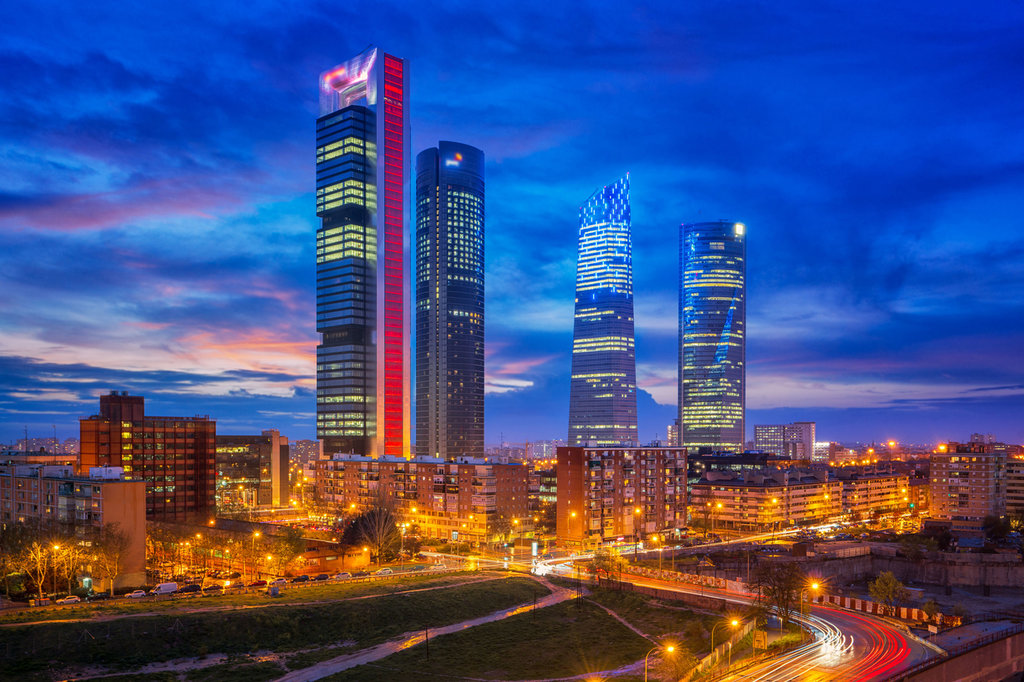Feature
Spain’s new lease of life (after Covid)
Despite difficult and uncertain global circumstances, the leasing market in Spain is seeing exciting opportunities in the digital and environmental frontiers, Chris Farnell reports.

Torres Kio, Puerta de Europa in Madrid, Spain. Credit: yiannisscheidt / Shutterstock.com
The Spanish leasing sector is, in many ways, an accurate reflection of the Spanish economy as a whole, given all the economic sectors and industries it covers. Given the weight of SMEs in Spain’s GDP (62.2%), the leasing sector sees demand spread throughout the country.
“Traditionally, this demand has been covered by the large local Spanish Banks that a long time ago adopted the Financial Lease as one of their core products,” says Alvaro Zafra, General Manager of DLL Iberia. “They leverage their customer knowledge and customer reach gained through longstanding relationships and their extensive branches’ networks. After that, captive and independent leasing companies entered the market, as well as other specialised companies offering more tailor-made solutions in each vertical, completing the actual landscape of the market.”
However, operating leases present a different situation. The car leasing business is the most extensively spread vertical in Spain, mainly driven by specialised companies and captives as opposed to local banks.
“These banks very frequently reach commercial and distribution agreements with these specialised companies. These types of partnerships are growing and becoming more relevant in other equipment finance verticals such as Technology and Office Equipment,” Zafra points out.
“A final differentiator of the Spanish leasing market is that there are fewer intermediaries, agents and brokers compared to neighbour countries in the South of Europe. “
Most of the world is still in recovery from the Covid-19 pandemic, and the Spanish leasing sector is no exception.
The leasing marketing in 2022 was very challenging in Spain. Performance fared better in comparison to 2021, but was still below 2019.
David Rodriguez, General Manager of Equipment & Logistics Solutions for the Iberia region at BNP Paribas Leasing Solutions
However, as Manuel García, General Secretary of the Spanish Association of Leasing and Renting (AELR) points out, the outlook is hopeful.
“Financial leasing in Spain in 2022 has practically reached the activity it had before the pandemic,” García says. “Movable leasing operations have performed better, reaching investment volumes similar to those achieved in 2019. Although, concerning real estate leasing, there has still been a difference that we attribute to the fact that in 2019 several high turnover operations were formalised that are making a difference today.”
Jarmila Spurova, CEO of SGEF Spain, also points to a promising performance in the leasing sector. “One of the main reasons has been the restart of the activity of our clients after the pandemic,” she tells us. “Nevertheless, from our point of view, there is room to grow during 2023.”
According to the information provided by the Spanish Leasing Association, the default rates remain stable, and the growth is diversified among all the assets SGEF finances. But the Spanish leasing sector is also a very diverse sector, with performance varying from market to market.
“For example, office equipment continues to decrease whilst IT and communications plus healthcare markets are strong, understandable given the focus in these areas post-covid,” says Carlos Barreiro, Head of Partnerships, Technology and Lifestyle Solutions in the Iberia region at BNP Paribas Leasing Solutions. “Demand for tractors and farm equipment slowed last year, whereas construction was up 14% vs the prior year. The materials handling sector remained flat. Other markets that are also growing include those linked to energy transition which are accelerating their growth and becoming more and more important.”
Indeed, across the board, the industry is seeing strong results from the IT and equipment sectors.
The Spanish leasing and renting market has experienced double-digit growth in the year 2022. IT and equipment leasing and renting have boosted this behaviour.
Marco Frühauf, Managing Director of GRENKE Spain
“Some segments doubled their 2021 volume.”
Frühauf puts this growth down to two sectors. The first is the push to get things back to normal, supported by the European Next Generation funding programs, the second is the need among Spanish companies to modernise and digitise.
“We expect that this trend continues in the next few months, as the modernisation degree of the Spanish SMEs is lower than in the neighbouring region,” Frühauf says.
Part of the reason for the growth the market is seeing is the work businesses are doing to survive in an increasingly uncertain economic environment.
“Of course, the uncertainty of the economic context will not help, but companies still need to invest to be efficient and take advantage of state-of-the-art equipment without incurring big expenses,” says Frühauf.
“The idea is no longer to own the asset at all costs but to benefit from the advantage it provides. In times where energy prices are high and expected to remain high, all industries are affected and need barely to improve their production facilities without jeopardising liquidity.”

Calle de Alcala and Gran Via, Madrid, Spain. Credit: Shutterstock
Navigating uncertainty
While the uncertainty in the economic environment and the world at large creates opportunities within the Spanish leasing sector, the sector itself also needs to adapt to new challenges.
“Without a doubt, uncertainty is what most affects business investment and, in this case, it is the war situation in Russia and Ukraine,” says García. “It is the source of the energy crisis, inflation, and more. Inflation will probably require rethinking new business projects, but planned maintenance investments will certainly be made.”
Frühauf argues that while the leasing industry is positioned to provide powerful tools to other businesses, the sector itself is also coming under pressure.
“It is once again evident that leasing is the tool of choice in times of high economic pressure,” Frühauf says. “Of course, the pressure on prices is also having an impact on us. This does not make the acquisition of customers and trade partners any easier. Because we are also forced to adjust our conditions. But we can only do this with a time lag.”
Spurova points to the rise in interest rates as a factor that is having a particular impact.
“In 2022, all the actors in the market have experienced a significant and continued rise in interest rates,” Spurova observes. “After more than ten years of stability in pricing, the situation has changed, and we are confronting how to ‘reinvent’ a way of accompanying and supporting our customers.”
Rodriguez also points to interest rates as a flashpoint for the industry.
“This has been acutely felt especially since we come from many years of flat rates that were bringing stability in the market,” Rodriguez says. “If we add elevated inflation and then the increased price of assets, this has created a perfect storm that forced us to adapt our internal processes, for example reducing the length of the validity of the proposals.”
One of those adaptations the leasing sector is moving to serve the booming demand for “as-service” business models.
“Leasing contracts are not only simple, fast and individual, but they have also developed into all-round carefree packages,” Frühauf says. “Leasing is more than a financing solution because it enables flexible contract models and additional services such as maintenance or integrated service packages. At the same time, flexible leasing terms also offer new options for long-term use. In combination with services to increase the service life of capital goods, this results in comprehensive concepts for conserving resources – and reducing costs.”

Cuatro Torres Business Area, Madrid, Spain. Credit: Shutterstock
A lot to offer
Indeed, among everyone we speak to across the Spanish leasing sector, one consistent element is a belief that the industry can step up to the challenges it is facing.
“The leasing companies have always been up to the demands made of them by Spanish companies and professionals,” says Garcia. “Even in the most difficult moments of the past financial crisis, no solvent project was left without financing.”
As well as the wider macroeconomic challenges the leasing sector faces, in Spain, there are also cultural factors that businesses like GRENKE must overcome.
“In a country where the sense of property is high and traditionally seen as a sign of status, we have to take every opportunity when talking to customers and partners to promote renting,” Frühauf points out. “We organise events by ourselves or together with other parties such as local associations, industry associations, and large manufacturers, to be the ‘apostles’ of leasing and renting and emphasising the advantages of leasing.”
Leasing is recognised as a preferred model for SMEs and businesses in low-populated areas, which traditional banks are less likely to serve.
“We support small- and medium-sized enterprises and the self-employed with smart financing regardless of their size and needs,” Frühauf tells us.
In these times where the financial standing of companies after the pandemic shows a sensitive deterioration, we try to analyse each application not only based on past performance but also based on the potential of the business.
There are plenty of entrepreneurs that need the support of companies like GRENKE when other key figures are more conservative.
“Probably the key point here has been to establish even closer collaboration with vendors to ensure every opportunity is reviewed to develop good solutions for all parties,” Rodriguez adds. “Vendor finance has always been about close communications between finance provider and vendor partner, so areas such as risk, fraud and residuals are carefully managed during periods of uncertainty.”
Together companies like BNP Paribas have been able to find ways to respond to these challenges creating solutions that fit the needs of finance providers, vendors, and clients. The Spanish leasing market is a resilient one. As Spurova points out, “During the growth or recession period, the impacts are smoother than in other markets and sectors.”
This means the Spanish leasing sector can use that stability to provide the necessary support to vendors and clients during turbulent times.
“To adapt our business to these challenges, we work closely with our vendors and customers to review our solutions regarding terms, interest rates and residual values, trying to offer the best value-add conditions to the market,” Spurova says.
The digital and green revolutions
Going forward, technology will be a key frontier in supporting the customers of the leasing sector.
“We see digital services as being a key area of differentiation,” Rodriguez tells us. “Equipment suppliers are looking for the autonomy to simplify how they service customers. Also, demand for new products such as rental, services and floorplan finance seems to be picking up.”
However, technology is only part of the equation. The other guiding force across the leasing sector is sustainability, and as Frühauf, in a place as sunny as Spain, solar power has big potential.
“More and more Spanish companies are investing in environmentally friendly technologies and technologies that improve productivity,” says Frühauf.
In a country with 300 sunny days per year, solar panels are the solution for many industries to reduce drastically energy costs. Some companies even get rid of the connection to the electric supplier and are served by solar panels exclusively.
This optimism is echoed by Spurova. “If I made a prediction about the future of the business, I would say there will be a strong focus on sustainable products and environmentally responsible financing,” says Spurova. “Aside from the compromise assumed by the governments in recent years, our customers demand these new solutions. In Societe Generale Equipment Finance (SGEF) strategy, defined during the last two years, there is a clear commitment to becoming ‘the worldwide partner for integrated equipment solutions creating a sustainable and positive impact on the planet’.”
Frühauf does point out that some green-orientated markets are taking a little longer to realise their potential, but the leasing sector is well positioned to help there.
“The very cost-sensitive regular Spaniard finds the price of an electric vehicle is often too high,” he says. “As a consequence of that the installation of electro chargers goes slow, besides the fact that Spain is a big country with low populated low demand areas, but big distances to cover between cities. Parallelly in the movables sector, more and more companies are relying on ‘green solutions’. These are increasingly financed via leasing or renting. Thus, customers can acquire and use these products very easily and conveniently without having to buy them immediately.”
Leasing and renting can become a catalyst for sustainable businesses, particularly small and medium-sized enterprises. It can be a boon to environmental solutions because it incentivises businesses to use the latest and most energy-efficient equipment and machinery. “It also sets impulses for green technologies such as photovoltaic systems, wall boxes, electricity storage and other solutions like solar pumps for agriculture and farming, a big industry in Spain,” argues Frühauf.
“I sincerely believe that the rental market has a bright future ahead of it, precisely because of this strong trend linked to the circular and share economy. We continue to work and push our digital solutions to be ever closer to our customers and partners through APIs and embedded connections. Bringing them simplicity via digital and sustainable solutions is one of our priorities and this is what will make rental even more attractive in the future.”